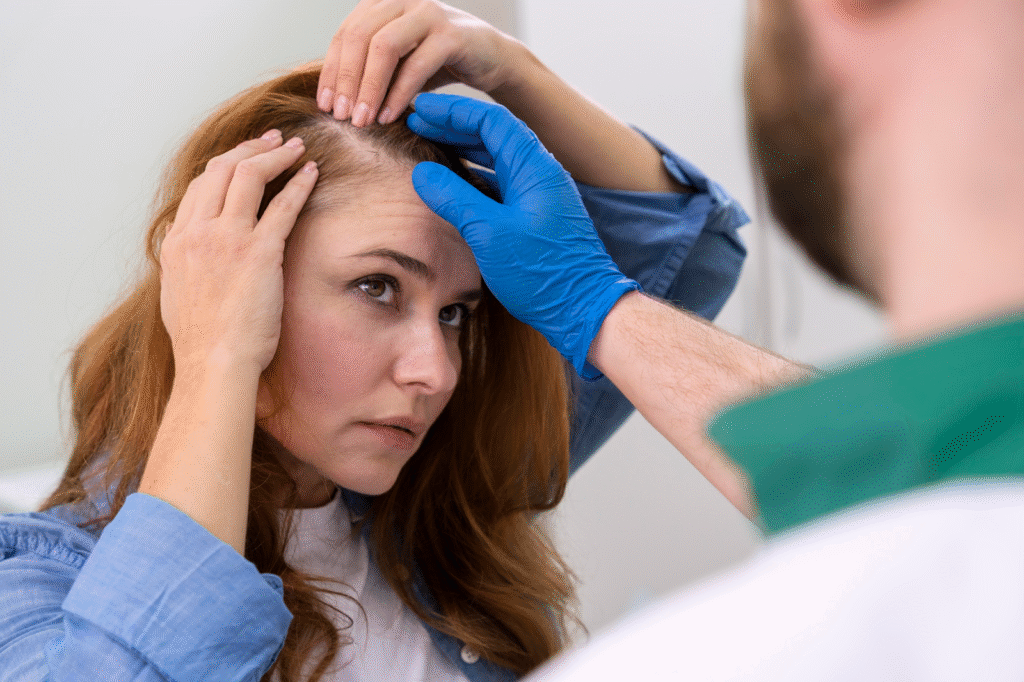Androgenetic or female pattern hair loss or Androgenetic alopecia is quite a common problem. Read on to find the risk factors like genetics, hormonal problems, stress and menopause.
Female hair thinning or loss is quite common for women across all ages. With age however, these problems start growing. Whether they are experiencing common hair thinning problems or are at risk of Androgenetic alopecia depends on certain factors and a proper diagnosis by a dermatologist.
40% of Canadian women experience some kind of hair loss by the time they reach 50. 125 hairs per day are lost on an average. The condition of Androgenetic alopecia in females however does not always have similar symptoms to general hair thinning. It is a disorder seen in women mostly after they hit menopause.
Risk Factors for Androgenetic Alopecia in Women
We provide you with a comprehensive list of risk factors for this hair loss condition in women.
Genetic Complexities
This condition of hair loss and thinning is mostly predisposed by genes. The family history and hereditary hair loss cases often trigger the condition of Androgenetic alopecia in females.
- Mutations in different genes often trigger this condition. Mostly changes in the AR gene in particular cause this condition.
- The 5-alpha reductase genes also often become the perpetrators causing Androgenetic alopecia in women.
- Family history of hair loss is a critical indicator for Androgenetic alopecia in women.
- Female pattern hair loss often stems from any of the parents having similar balding problems.
It is important to consider your family history on hair loss and find out if you fall under this risk category.
Hormonal Imbalance
Female pattern baldness, dermatologically termed as Androgenetic alopecia is common among women who are on the brink of their menopause or have already entered that phase.
- Hormones are mainly associated with changes in one’s body. Hormones not only change the body but also stabilizes it.
- Usually, androgenetic alopecia is observed in ageing women. It can however become prominent at a young age if there are major hormonal issues.
- Hormonal hair loss is gradual but visible. If one is facing menopause, PCOD or similar hormonal issues they are at risk of Androgenetic alopecia (alopecie)
- Androgenetic alopecia in women can be heavily triggered by imbalance in thyroid hormones, cortisol, and testosterone.
For Androgenetic alopecia one needs to consult a dermatologist. Get checked by an endocrinologist if you believe the hormonal problems are causing hair loss.
Stress Causing Hair Loss
Mental stress has long been considered as one of the key factors behind hair loss. We discuss if this also applies to the condition of Androgenetic alopecia in women rather than just for normal hair loss.
- Female pattern hair loss is caused more by heredity than stress.
- High levels of mental stress have the power to trigger female pattern baldness if the other risk factors like family history of hair loss are at play.
- Mostly, for women with hair loss or thinning problems stress is a by-product. This only worsens the situation and regular occurrence puts them at the risk of having Androgenetic alopecia.
- Mental stress directly forces the immune system to affect the hair follicles.
A study suggests, 63% of the working women in Canada experience high levels of stress while balancing family and career. The stress in women might not directly cause Androgenetic alopecia but definitely does worsen the hair loss issue.
The Age Factor
With the aging factor in place women become more vulnerable to the pattern hair loss condition. Whether they are male or female, all androgenetic alopecia patients have symptoms before they reach 40. The conditions only become prominent with regular hair loss and balding, after 40.
- The female pattern hair loss starts somewhere around the age of 12 to 40 years.
- People are likely to have Androgenetic alopecia (alopecie) before reaching midlife.
- The condition is mostly seen in women experiencing menopause. 75% of women over 65 years are affected by the female pattern hair loss.
- The likelihood of women facing this condition is greater for women above 65 years as menopause and the hormonal imbalance influence the hair loss.
Risks listed here are the most prominent ones. There are other secondary factors which are not directly related to Androgenetic alopecia for women, but definitely influence health conditions that cause hair loss. If you feel that you fall under any of these risk categories, contact a dermatologist to check if you have early onset of alopecia or just regular hair fall issues.
In Summation
Androgenetic alopecia in females is mostly influenced by genetic predisposition or hormonal disbalances. The combination of these two factors along with added stress and aging can make women vulnerable to the condition.
Want to Get Yourself Checked for Androgenetic Alopecia?
Find the best dermatologists and hair treatment centres in Canada and select the one most convenient for you!

